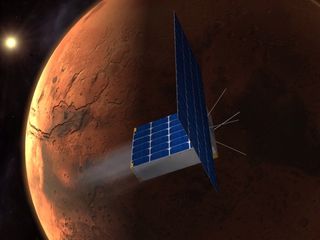These Students Want to Send a Time Capsule to Mars

WASHINGTON — A student-led project aims to send a time capsule to Mars for future explorers to discover, its organizers announced today (June 23).
Time Capsule to Mars (TC2M), a project of the nonprofit organization Explore Mars, plans to land three small satellites, known as CubeSats, on the surface of the Red Planet within the next five years. The satellites will contain images, videos and other forms of expression from people around the globe, according to the project's organizers.
If successful, the $25-million mission would be the first privately funded mission to Mars, the first student-led mission to another planet, the first trial of a new propulsion system and the first interplanetary CubeSat, the team said here today in a press briefing. [7 Most Mars-like Places on Earth]
"We've got a lot of firsts, and it's very exciting," said Emily Briere, a senior at Duke University in Durham, North Carolina, and the mission's founder and director.
Briere told reporters that "millions of people from around the world [will be able to] send in their photo, their picture of their dog, their handwritten poem, and feel that they themselves are going to Mars and making an impact."
Crowd-funded craft
To pay for the mission, its organizers are launching the largest crowdfunding campaign in history.
Sign up for the Live Science daily newsletter now
Get the world’s most fascinating discoveries delivered straight to your inbox.
"We were looking for opportunities to fund this mission in a way that would involve as many people as possible," said Jon Tidd, a Duke University graduate student and director of fundraising and marketing for the mission.
The team came up with the idea that people from anywhere in the world would be able to pay 99 cents to upload an image (and eventually text, audio or video clips) aboard the spacecraft. People in developing countries can submit images for free with the help of corporate sponsors.
Say you have a picture of your granddaughter, an inspirational quote or a painting that you think humanity would cherish one day, Tidd said — "we're going to take that for you to the surface of Mars."
The project has echoes of the famed Golden Records, launched aboard NASA's twin Voyager spacecraft in 1977, which contained sounds and images selected to represent life and culture on Earth to any civilization that may find them. The Voyager I spacecraft became the first manmade object to leave the solar system when it entered interstellar space in August 2012.
The team aims to involve K-12 students in particular, who will be able to follow the vehicle as it moves through space and take part in the mission virtually through personalized "mission control" portals.
The mission is centered at the Space Propulsion Laboratory at MIT, in Cambridge, Massachusetts, and includes students from Duke University, Stanford University and the University of Connecticut. Aerospace experts have also pledged their support, including NASA, ATK, Aerojet Rocketdyne, Deep Space Industries, Draper Laboratory, Lockheed Martin, Remarkable Technologies and Uwingu.
Charlie Precourt, vice president and general manager of ATK, a Virginia-based aerospace company, and a former astronaut who flew on four space shuttle missions, is serving as a special advisor to the project, along with fellow ATK Vice President Kent Rominger.
"I can't imagine when I was fresh out of college doing what they're doing — it's really amazing," Precourt told Live Science.
The project goes hand-in-hand with manned Mars missions, Precourt said, adding, "We really believe as the senior members of the space community that we will be putting astronauts on Mars within the next couple of decades."
Testing new tech
The team members wouldn't comment on details of the launch, although they have chosen a tentative date and will release more information soon, they said.
The mission will also test new technologies for propulsion and data storage.
The three 6.1-cubic inch (100 cubic centimeters) CubeSats will be powered by an ion electrospray propulsion system developed at MIT, which uses strong electric fields to extract and accelerate charged particles, or ions. The system is much more compact than comparable propulsion systems and could reduce the travel time to Mars, the project's leaders said.
In addition, the mission plans to use quartz storage technology capable of preserving the data for millions of years. The mission will also employ Delay Tolerant Networking, a form of computer networking designed for disruptive environments, as part of testing for a future deep-space Internet.
Follow Tanya Lewis on Twitter and Google+. Follow us @livescience, Facebook & Google+. Original article on Live Science.
